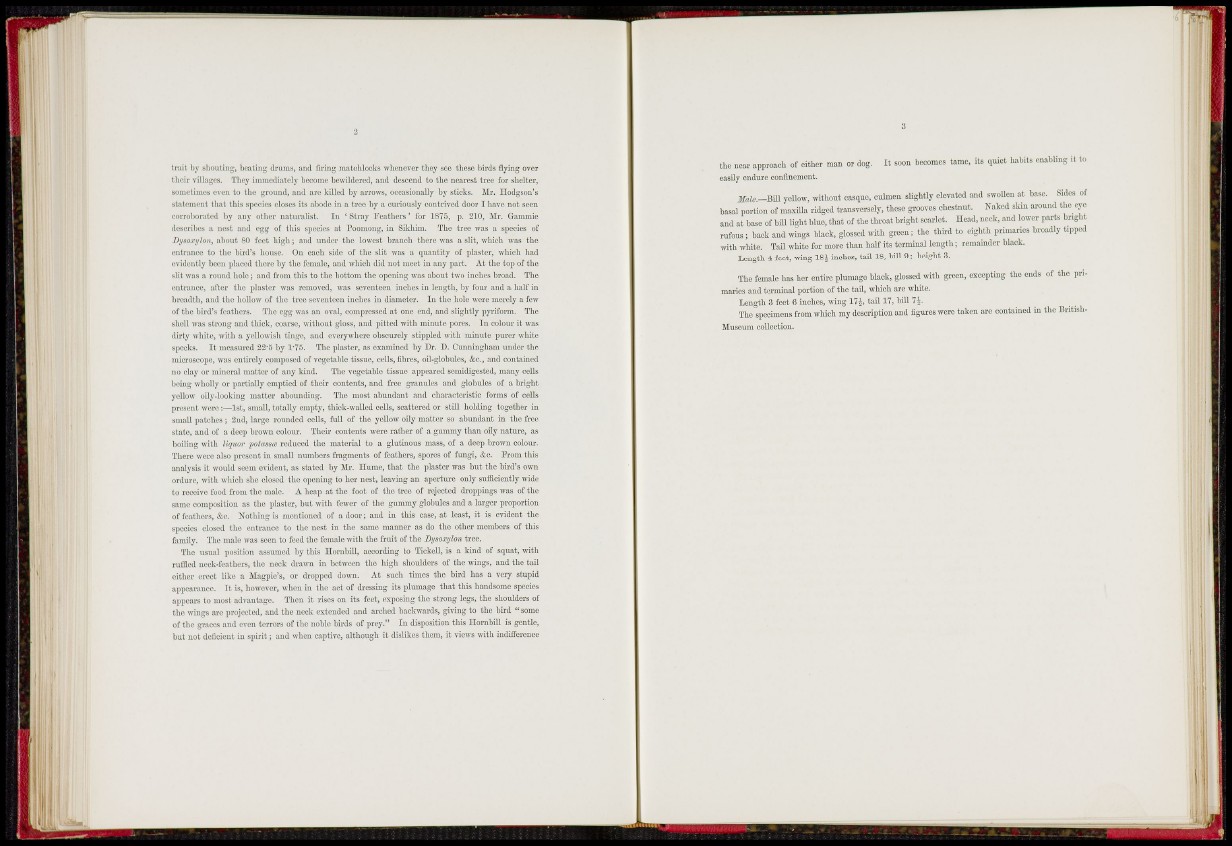
trait by shouting, beating drums, and firing raatclilocks wlienever they see these birds flying over
their villages. They immediately become bewildered, and descend to tlic nearest tree for shelter,
sometimes even to the ground, and are killed by arrows, occasionally by sticks. Mr. Ilodgson's
stiitenicmt that this spccies doses its abode in a tree by a curiously contrived door I have not seen
corroborated by any other naturalist. In ' Stray Pcatliers' for 1875, p, 210, Mr. Gammie
describes a nest and egg of tins species at Poomong, in Sikhim. The tree was a species of
Ihjsoxylon, about 80 feet high; and under the lowest branch there was a slit, which was the
entrance to the bird's house. On each side of the slit was a quantity of plaster, which had
evidently been placed there by the female, and which did not meet in any part. At the top of the
slit was a round hole; and from this to the bottom the opening was about two inches broad. The
entrance, after the plaster was removed, was seventeen inches in length, by four and a half in
l)readth, and the hollow of the tree seventeen inches in diameter. In the hole were merely a few
of the bird's feathers. The egg M-as an oval, compressed at one end, and slightly pyrifoim. The
shell was strong and thick, coarse, without gloss, and pitted with minute pores. In colour it was
dirty white, with a yellowish tinge, and everywhere obscurely stippled with minute purer white
specks. It measured 22-5 by 1-75. The plaster, as examined by Dr. D. Cunningham under thci
microscope, was entirely composed of vegetable tissue, cells, libres, oil-globules, &c., and contained
no clay or mineral matter of any kind. The vegetable tissue appeared semidigested, many cells
b(;ing wholly or partially emptied of their contents, and free granules and globules of a bright
yellow oily-looking matter abounding. The most abundant and eliaracteristic forms of cells
present wore:—1st, small,totally empty, thick-walled cells, scattered or still holding together in
small patehcs; 2nd, large rounded cells, full of the yellow oily matter so abundant in the free
state, and of a deep brown colour. Their contents were rather of a gummy than oily nature, as
boiling with liquor potassa rcduecd the material to a glutinous mass, of a deep brown colour.
There were also present in small numbers fragments of feathers, spores of fungi, &c. Prom this
analysis it would seem evident, as stated by Mr. Hume, that the plaster was but the bird's own
ordure, with which she closed the opening to her nest, leaving an aperture only sufficiently wide
to rceeive food from the male. A heap at the foot of the tree of rejected droppings was of the
same composition us the plaster, but with fewer of the gummy globules and a larger proportion
of feathers, &c. Nothing is mentioned of a door; and in this case, at least, it is evident the
spccies closed tlie entrance to the nest in the same manner as do the other members of this
family. The male was seen to feed the female with the fruit of the Bysoxylon tree.
The usual position assumed by this Ilornbill, according to Tickell, is a kind of squat, with
ruffled neck-feathers, the neck drawn in between the high shoulders of the wings, and the tail
either ercct like a Magpie's, or dropped down. At such times tlie bird has a very stupid
appcarauce. It is, however, when in the act of di-essing its plumage that this handsome species
appears to most advantage. Then it rises on its feet, exposing the strong legs, the shoulders of
the wings are projected, and the neck extended and arched backwards, giving to the bird "some
of the graces and cvea terrors of the noMe birds of prey." lu disposition tliis Hombill is gentle,
but not deiieient in spirit; and wlien captive, although it dislilies them, it views with indifference
Xt soon becomes tame, its quiet h the near approach of either man or d abits enabling it to
easily endure eonlinement.
JKife—Bill yellow, without casque, culmcn sligMlj elevated and swoUen at base. Sides of
basal portion of maiilla ridged transversely, these grooves chestnut. Naked skin around the eye
and at base of bill light blue, that of the throat bright scarlet. Head, neck, and lower parts bright
rufous i back and wings black, glossed with greenthe third to eighth primaries broadly t.pped
with white. Tail white for more than half its terminal length; remainder black.
Length 4 feet, wing ISJ- inches, tail 18, bill 9; height 3,
The female has her entire plumage black, glossed with green, excepting tho ends of tlie primaries
and terminal portion of the tail, which are white.
Length 3 feet 6 inches, wing 17^, tail 17, hill
The specimens from wliich my description and figures were taken are contained in the British-
Museum collection.
i,: :l